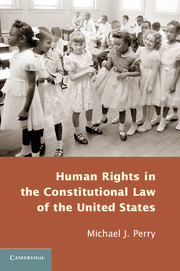Book contents
- Frontmatter
- Dedication
- Contents
- About the Author
- Introduction: Human Rights in the Constitutional Law of the United States
- Part I The Morality of Human Rights
- 1 The Internationalization of Human Rights
- 2 What is a “Human Right”?
- 3 The Normative Ground of Human Rights
- Part II The Constitutional Morality of the United States
- Concluding Note
- Index
- References
1 - The Internationalization of Human Rights
Published online by Cambridge University Press: 05 July 2013
- Frontmatter
- Dedication
- Contents
- About the Author
- Introduction: Human Rights in the Constitutional Law of the United States
- Part I The Morality of Human Rights
- 1 The Internationalization of Human Rights
- 2 What is a “Human Right”?
- 3 The Normative Ground of Human Rights
- Part II The Constitutional Morality of the United States
- Concluding Note
- Index
- References
Summary
A basic understanding of the morality of human rights, as I said in the Introduction, greatly enhances our understanding of the constitutional morality of the United States. My aim in Part I is to provide that basic understanding. I begin, in this chapter, by sketching the internationalization of human rights: the growing international recognition and protection, in the period since the end of the Second World War, of certain rights as human rights. In the next chapter, I explain what it means, in the context of the internationalization of human rights, to say that a right is a “human right.”
THE NAME OF MY STATE OF ORIGIN – Kentucky – has been said to derive from a Native American word meaning “a dark and bloody ground.” An apt name for my century of origin is a dark and bloody time – indeed, the dark and bloody time: the twentieth century “‘was the bloodiest in human existence,’…not only because of the total number of deaths attributed to wars – 109 million – but because of the fraction of the population killed by conflicts, more than 10 times more than during the 16th century.”
- Type
- Chapter
- Information
- Publisher: Cambridge University PressPrint publication year: 2013

